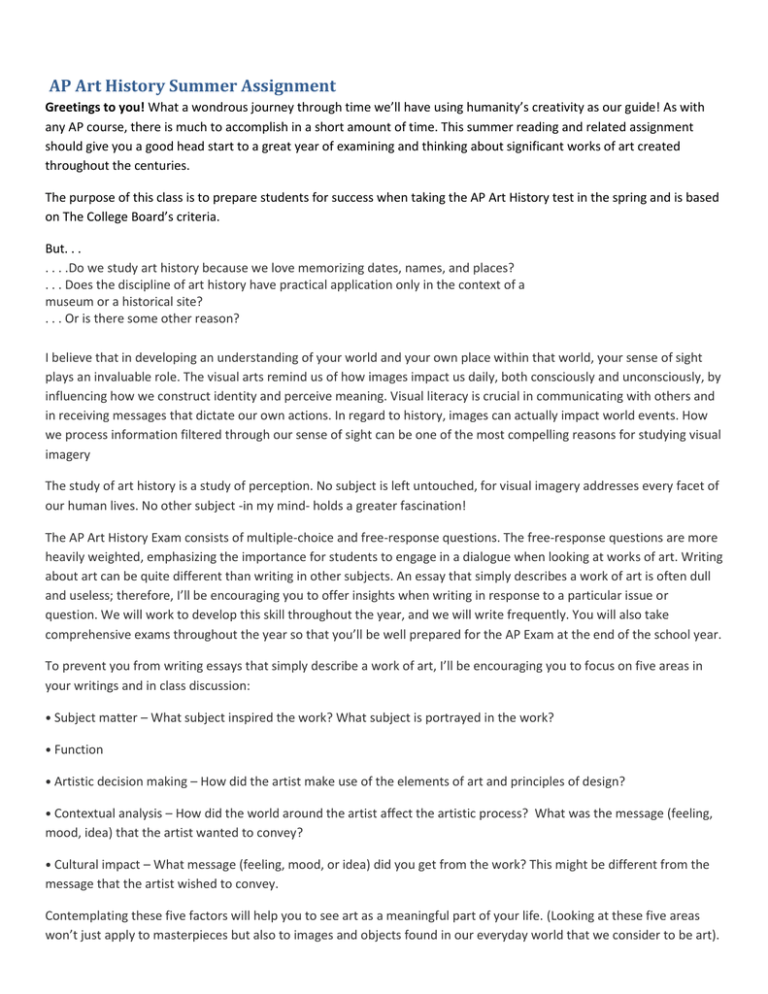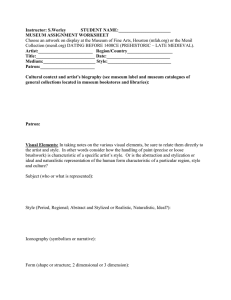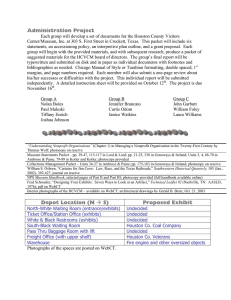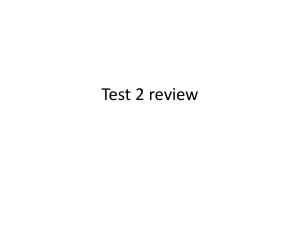AP Art History Summer Assignment
advertisement

AP Art History Summer Assignment Greetings to you! What a wondrous journey through time we’ll have using humanity’s creativity as our guide! As with any AP course, there is much to accomplish in a short amount of time. This summer reading and related assignment should give you a good head start to a great year of examining and thinking about significant works of art created throughout the centuries. The purpose of this class is to prepare students for success when taking the AP Art History test in the spring and is based on The College Board’s criteria. But. . . . . . .Do we study art history because we love memorizing dates, names, and places? . . . Does the discipline of art history have practical application only in the context of a museum or a historical site? . . . Or is there some other reason? I believe that in developing an understanding of your world and your own place within that world, your sense of sight plays an invaluable role. The visual arts remind us of how images impact us daily, both consciously and unconsciously, by influencing how we construct identity and perceive meaning. Visual literacy is crucial in communicating with others and in receiving messages that dictate our own actions. In regard to history, images can actually impact world events. How we process information filtered through our sense of sight can be one of the most compelling reasons for studying visual imagery The study of art history is a study of perception. No subject is left untouched, for visual imagery addresses every facet of our human lives. No other subject -in my mind- holds a greater fascination! The AP Art History Exam consists of multiple-choice and free-response questions. The free-response questions are more heavily weighted, emphasizing the importance for students to engage in a dialogue when looking at works of art. Writing about art can be quite different than writing in other subjects. An essay that simply describes a work of art is often dull and useless; therefore, I’ll be encouraging you to offer insights when writing in response to a particular issue or question. We will work to develop this skill throughout the year, and we will write frequently. You will also take comprehensive exams throughout the year so that you’ll be well prepared for the AP Exam at the end of the school year. To prevent you from writing essays that simply describe a work of art, I’ll be encouraging you to focus on five areas in your writings and in class discussion: • Subject matter – What subject inspired the work? What subject is portrayed in the work? • Function • Artistic decision making – How did the artist make use of the elements of art and principles of design? • Contextual analysis – How did the world around the artist affect the artistic process? What was the message (feeling, mood, idea) that the artist wanted to convey? • Cultural impact – What message (feeling, mood, or idea) did you get from the work? This might be different from the message that the artist wished to convey. Contemplating these five factors will help you to see art as a meaningful part of your life. (Looking at these five areas won’t just apply to masterpieces but also to images and objects found in our everyday world that we consider to be art). Here are your summer assignments: I. Read the Introduction: ‘What is Art?’ and Chapter 1: ‘Art Before History’ from Gardner’s Art through the Ages (folders that contain the scanned pages are available with this instruction sheet – on the Counseling Center website, on my website, and in our Google folder, which I have shared with you all). This is the Introduction and first chapter of your coursework. Take note of the name, approximate date, and significance of each work. Define each of the terms listed in your own words, as found in the reading (don’t just use a dictionary as you might not get the same definition I want you to use): a. Incise j. Trilithon b. Mesolithic k. Carbon 14 c. Post and lintel l. Jericho d. Twisted perspective m. Catal Huyuk e. Paleolithic n. Monolith f. Neolithic o. Megalith g. Venus of Willendorf p. Lascaux h. Dolmen q. Altamira i. Cromlech In addition to those terms, please make sure you are familiar with (know the name, century created and significance of these art objects): Apollo 11 Stones Great Hall of the Bulls Camelid Sacrum (in the shape of a dog) Running Horned Woman rock painting Bushel with Ibex Motif Anthropomorphic Stele from the Arabian Peninsula (see photo below) Jade Cong (see photo below) Stonehenge The Ambum Stone Tlatico female figurine Terra cotta fragment from the Solomon Islands Here’s a hint about having information about these objects – not all of them are discussed in our text, but they are all related to information you need for the exam. Many of the chapters will contain objects on our list to study that are not included in our text. Try to collect information from credible sources. II. Exhibit Review – Sometime over the summer, visit a gallery or museum and write up your experience. In about two pages (double-spaced, 12 point type) explain the exhibit/museum that you visited, make mention of a few of the pieces that caught your eye, and discuss why and how they engaged you as a viewer. The reading, Writing a Review of an Exhibition, is included in your reading packet to assist you with this assignment. If you want to combine two assignments into one and collect information from the Columbus Museum of Art for this (part II) then please use whatever temporary exhibit is on at the museum for this section. This paper is your admission ticket into the class on the first day of school. III. Your own personal collection of art – Become an art expert about three pieces of work from different time periods in the Columbus Museum of Art permanent collection. Please log onto Google Docs using your school account and type the three paintings that you are choosing to study on the document that I’m sharing with you – no repeats will be accepted. I will post a suggested list of paintings that you can choose from. Please make sure no one has already claimed any of the ones you want before you start researching them. Ideally, I’d like you to sit with and really look your work of art before you study it, and again after you study it. Going to the museum is optional for part III (the information is the important part). My goal for this part is to get a writing sample from you at the beginning of the year. It’s also meant to encourage you to visit the museum and sit for a while and experience actual works of art (if you’ve never been, it’s a different experience from just seeing them in a book/magazine/online). If you find that you need guidance, I will be checking my e-mail – scottjo@delawarecityschools.net throughout the summer. Please contact me as needed. (While it’s my goal to assist you quickly, over the summer it may take me some time to get back to you – please bear with me in this process and thank you for your patience.) See you in August! JS:je









